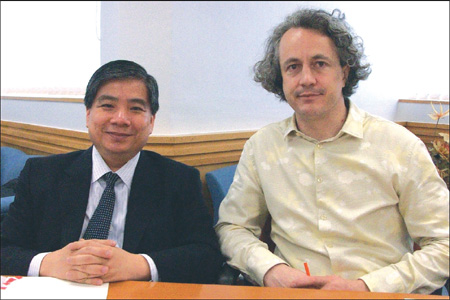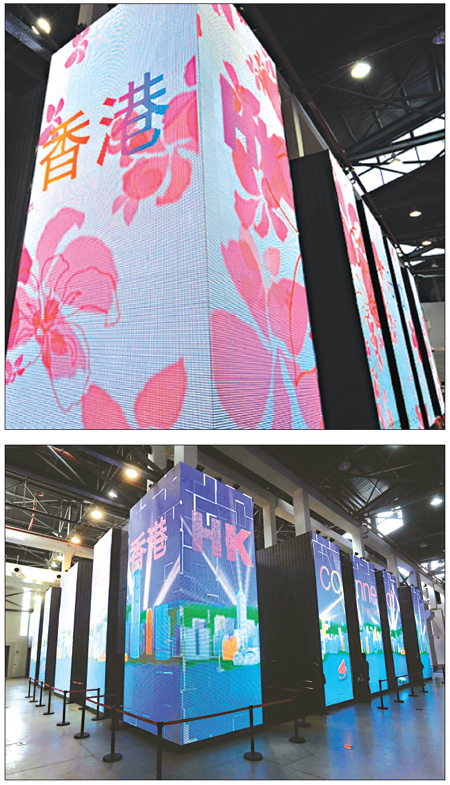Shanghai World Expo 2010: Hong Kong, the 'Smart City'
Updated: 2010-05-27 07:34
By Joseph Li(HK Edition)
|
|||||||
From the magnificence of Hong Kong's skyline, to the solitary recesses of its urban parks; from tradition to high technology, Hong Kong is being showcased in an Expo 2010 exhibit highlighting the best in urban living. Joseph Li reports.
One area at the Shanghai World Expo 2010 where Hong Kong really shines is in an all new exhibit titled the Urban Best Practices Area (UBPA), tied to the Expo theme of "Better City, Better Life."
Here, people from all over the world have a chance to view for themselves some of what makes Hong Kong stand out among international cities.
In order to qualify to exhibit at the UBPA, prospective bidders had to compete. Applications were reviewed by representatives from various United Nations agencies and other international organizations. Hong Kong was one of the successful applicants. The city's exhibits highlight Hong Kong's high-quality living, through widespread use of Smart Card technology; its connectivity through radio frequency identification technologies (RFID) and its strengths in creativity and innovation.
Hong Kong's exhibit at the UBPA focuses on the theme, "Smart Card, Smart City, Smart Life", re-echoing the Expo theme, Alan Siu, Deputy Secretary for Commerce and Economic Development, told China Daily.
"The idea is to highlight the various contrasts of Hong Kong, for example Cantonese opera versus modern life," Siu said enthusiastically.
As visitors come to the entrance of Hong Kong's UBPA exhibition hall, they are met by impressionistic representations of Hong Kong revealed on a six-meter-high LED facade.
The graphics are on themes highlighting the famous skyline; the iconic Bauhinia is there; so is the mass transit railway system.
The display is designed so that each time someone enters the Hong Kong hall, he becomes represented as a pixel on the LED screen, which then becomes part of the compilation of the graphics.
Inside, a two-minute film titled "Faces of Hong Kong" gives visitors an introduction to the city.
"The movie is shown on a 360-degree horizontal circular projection screen which interacts with 14 vertical LED displays," he said. "Visitors will be able to experience the multi-faceted nature of Hong Kong through the video."
Here one discovers some of the marked contrasts of Hong Kong, offering viewers many different perspectives through audio and visual effects: frenetic and tranquil; ultra-urban and unspoilt nature; modern and traditional; East and West; urban development and conservation.
Siu went on to illustrate that each of the 14 virtual hosts represents an ordinary citizen of Hong Kong, who leads a one-minute tour of daily life in the city.
Here is where visitors are given an introduction revealing just how much Smart Card and RFID technologies play a part in city life in Hong Kong.
The smart card, a bold step toward a cashless society, makes life easier, safer and more convenient for millions of people in Hong Kong. The virtual tours demonstrate how smart cards are used for shopping, public transportation, access to buildings and car parks, the auto toll system, school attendance, automated booking services and immigration clearance, Siu explained.
The UBPA exhibition also features various applications of the RFID technology. For example, the Hong Kong International Airport is one of the only two airports in the world using the RFID technology to handle passenger cargoes.
The exhibition also features other RFID applications in logistics and supply chain management, food safety management, retail management and library management, etc.
"The initial idea for the UBPA exhibition originated from the government, in consultation with the creative industry," he disclosed.
"We then commissioned a concept designer to materialize our concepts in December 2007 and we were informed we were selected to run the exhibition in early 2008. We had a separate contractor responsible for building the pavilion and setting up the content and exhibits."
Marc & Chantal Design, a Hong Kong-based company founded by a Swiss, Marc Brulhart, was assigned the concept design job after tendering.
Brulhart, a partner of the company, has been living in Hong Kong for 19 years and knows the city well. The company, which has a small team of some 30 people, including locals and expatriates, designers and architects, started working in 2007 after winning the bid.
"Our aim was to design something that can best present the Hong Kong spirit," said Brulhart.
"We designed a series of images that represent Hong Kong. One of the main features is the accumulation of pixels on the graphic walls that slowly form shapes and words that evolve day by day when visitors arrive at the exhibition.
"The other thing is that Hong Kong is very well-connected as an economic city from its banking system to transportation. With the help of the smart card through RFID technology, people enjoy an easy, convenient daily urban life in many aspects."
Brulhart went on to say that the purpose of the 360-degree circular screen movie is to give visitors a clear concept of Hong Kong.
Many people think Hong Kong is very "vertical" because it has many buildings, he said, but the city is also an island with a lot of sea and greenery.
Getting the exhibit put together was a tight squeeze. The site of the UBPA exhibit is a former power plant that wasn't even renovated until last year, so the team had only six months to assemble the exhibition.
"It was a very tight process because we had no more than three years to prepare for the exhibition. It was rather challenging, given we had to do most of the work in Shanghai while we were in Hong Kong. So we had to fly to Shanghai very frequently to check the progress," he said.
"We are very pleased that after two or three years of hard work, we finally see the realization of our plan," he said with a smile.
As to the visitor attendance, the daily attendance averaged 3,000 - 4,000 in the first few days.
"The visitors were very impressed, and have said the UBPA exhibition is very dynamic and demonstrates the vitality of Hong Kong," Siu said. "It is a fair comment because our exhibition is quite dynamic as compared with other exhibitions that are a bit static."
Brulhart never laid eyes on the Hong Kong UBPA exhibition prior to the Expo's opening day. He said he planned to visit the site and see the exhibit for the first time on May 16.
However, from what he had been able to observe from afar he said he was pleased, because the exhibition hall achieved its purpose of presenting an impression to the world of Hong Kong as a vibrant city that keeps changing.
Brulhart and his company did the preparatory work in Hong Kong and flew to Shanghai occasionally to check on progress, while a separate contractor was appointed to take charge of the installation work.
Asked how he was able to ensure that the final touches were to his satisfaction as concept designer, Brulhart smiled and said: "You've always got to trust people."
|
Above 2: The LED facades at the Hong Kong's UBPA exhibition hall at the Shanghai Expo reveal impressionistic representations of Hong Kong to visitors. The graphics on the LED walls are charged by and react to the presence of the visitors. Blow: Alan Siu (left), Deputy Secretary for Commerce and Economic Development, together with Marc Brulhart, founding partner of Marc & Chantal and concept designer of Hong Kong's UBPA exhibition. Provided to China Daily |

(HK Edition 05/27/2010 page2)
